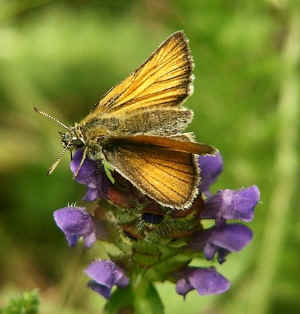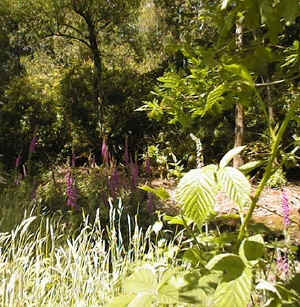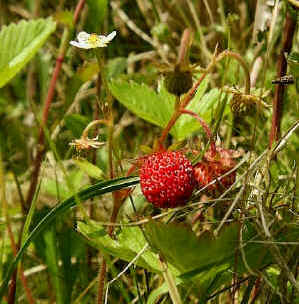 |
Plant diversity within
a woodland will also be enhanced by the presence of rides and tracks through the wood.
These act as long narrow glades which open up the woodland to light. Road and ride edges
provide major habitats for flowering plants and animals such as this skipper butterfly,
nectaring on flowers of Self-heal (left). The orientation and width of the rides will significantly influence the hours of sunlight received by areas within the ride. In southern Britain, an East/West oriented ride will receive almost twice as many hours of sunlight as a North/South ride. The taller the trees adjacent to the ride, ideally, the wider the ride should be. A minimum width of about 18m for an East/West ride with adjacent trees of 20m tall would allow for about 10 hours of continuous sunshine a day on the southern side of the ride1. This has dramatic effects on the microclimate, creating conditions for a wide range of plants and invertebrates to flourish. |
| . | |
 |
Rides will have much
greater wildlife benefits if there is a gradual transition from a central grassy area,
through taller herbaceous vegetation, brambles and shrubs before reaching the trees (left). This creates much
greater plant diversity than an abrupt transition from the grassy central area straight to
the woodland trees. Long straight rides can act as wind tunnels if they face the prevailing wind. This makes them less attractive to wildlife. To avoid this, rides can be curved or bent at intervals, if possible. They can also be angled just before they emerge from a woodland to lessen a funneling effect. The edges of the rides can be scalloped or bayed rather than being straight, which will also help to lessen wind funneling. |
| . | |
 |
Individual scallops or
bays should preferably be cut on a rotational basis. Rotational cutting can be alternated
from side to side of the ride, as well as being staggered along its length. This adds
structural variety and diversity by creating different stages in a ride-side succession.
This type of management continually opens up areas where a variety of small herbs such as
wild strawberries (left) can flourish. Cutting frequencies will depend on local conditions and local species. In general shrubs will need to be cut every 3 - 7 years and grass swards every 2 - 5 years. Cutting should be left at least until October to allow invertebrates and birds to complete their lifecycles. |
1Carter, C.I. and Anderson, M.A. (1987) Enhancement of Lowland Forest Ridesides and Roadsides to Benefit Wild Plants and Butterflies. Forestry Commission, Research Information Note 126. Issued by the Forestry Commission Research Division. |
|